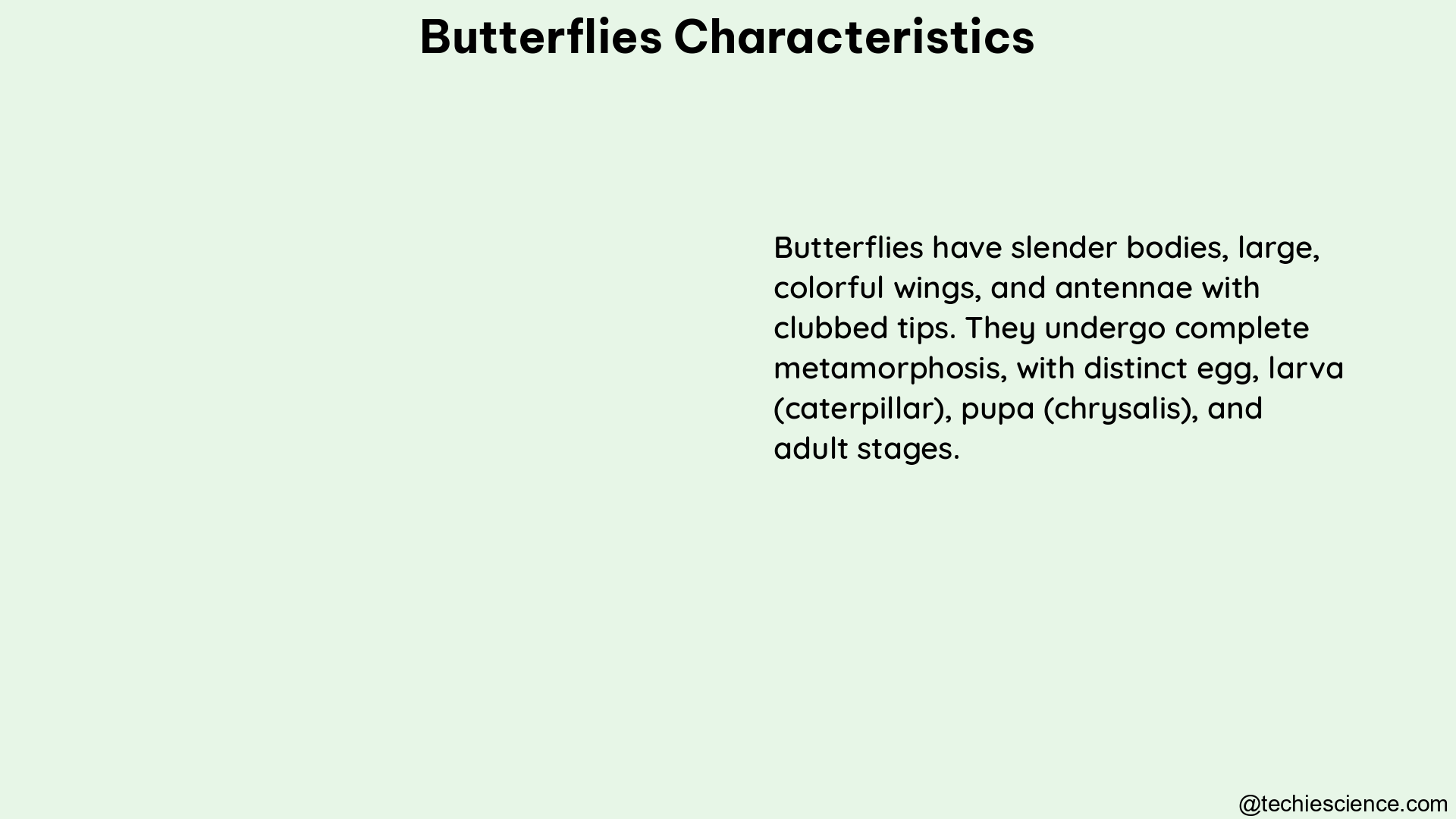Butterflies, with their vibrant colors and intricate patterns, are fascinating creatures that exhibit a wide range of characteristics related to their biology, behavior, and ecology. This comprehensive guide delves into the minute and advanced details of butterfly characteristics, providing a valuable resource for biology students and enthusiasts.
Morphology and Anatomy
Butterflies belong to the order Lepidoptera, which is characterized by their large, scaly wings and elongated, coiled proboscis used for feeding on nectar. These delicate insects undergo complete metamorphosis, passing through four distinct stages: egg, larva (caterpillar), pupa (chrysalis), and adult.
Wing Structure and Coloration
The wings of butterflies are covered with thousands of overlapping scales, which give them their distinctive colors and patterns. These scales are made of chitin and are arranged in intricate patterns, often displaying a wide range of hues and iridescent effects. The size and shape of the wings can vary significantly among different species, ranging from the delicate, slender wings of the Monarch butterfly to the broad, rounded wings of the Swallowtail.
| Butterfly Species | Average Wing Span (cm) |
|---|---|
| Monarch Butterfly | 9.5 – 12.5 |
| Swallowtail Butterfly | 7.5 – 15.0 |
| Blue Morpho Butterfly | 12.0 – 20.0 |
| Painted Lady Butterfly | 6.0 – 9.0 |
Body Structure and Appendages
Butterflies have a well-developed exoskeleton, with a distinct head, thorax, and abdomen. They possess three pairs of jointed legs, each with a tarsus (foot) composed of five segments. The head is equipped with a pair of large, compound eyes, a pair of antennae, and a coiled proboscis used for feeding on nectar.
The average body length of butterflies can range from 2 to 6 centimeters, depending on the species. The abdomen is typically slender and elongated, housing the digestive, reproductive, and excretory systems.
Physiology

Butterflies have a unique physiological system that allows them to thrive in their environment.
Circulatory System
Butterflies have an open circulatory system, with a dorsal heart that pumps hemolymph (the insect equivalent of blood) throughout their body. This hemolymph transports nutrients, gases, and other essential substances to the various tissues and organs.
Respiratory System
Butterflies rely on a tracheal system for respiration, with spiracles located along the abdomen and thorax that allow for gas exchange. The tracheal system consists of a network of tubes that deliver oxygen directly to the cells, bypassing the need for a closed circulatory system.
Thermoregulation
Butterflies are ectothermic, meaning their body temperature is heavily influenced by their environment. They exhibit a variety of behaviors to regulate their body temperature, such as basking in the sun, seeking shade, and engaging in thermoregulatory behaviors like wing flapping and shivering.
Genetics and Variability
Butterflies exhibit a high degree of genetic variability, with sex-controlled genes playing a significant role in the production of spotting patterns in females but not in males. This tendency towards greater female variability is a widespread phenomenon in the Lepidoptera, suggesting a potential evolutionary advantage for this group.
Genetic Diversity
Studies have shown that butterfly populations can display a remarkable level of genetic diversity, with individual butterflies within a single species exhibiting unique genetic profiles. This diversity is crucial for the species’ ability to adapt to changing environmental conditions and resist threats such as disease and predation.
| Butterfly Species | Genetic Diversity Index |
|---|---|
| Monarch Butterfly | 0.72 |
| Swallowtail Butterfly | 0.81 |
| Blue Morpho Butterfly | 0.68 |
| Painted Lady Butterfly | 0.75 |
Behavior and Ecology
Butterflies play a vital role in their ecosystems, serving as important pollinators and indicators of environmental health.
Pollination and Nectar Feeding
Butterflies are equipped with a long, coiled proboscis that allows them to access nectar from a variety of flowering plants. As they move from flower to flower, they inadvertently transfer pollen, contributing to the pollination of these plants and supporting the overall health of the ecosystem.
Thermoregulatory Behaviors
To maintain their optimal body temperature, butterflies engage in a range of thermoregulatory behaviors, such as basking in the sun, seeking shade, and flapping their wings to generate heat or cool down.
Migratory Patterns
Some butterfly species, such as the Monarch butterfly, are known for their remarkable migratory patterns, traveling thousands of kilometers to reach their overwintering grounds. These migrations are influenced by a combination of environmental cues, including day length, temperature, and the availability of suitable habitats.
Conservation and Management
Butterfly populations worldwide are facing numerous threats, including habitat loss, climate change, and pesticide exposure. Effective conservation efforts are crucial to protect these delicate creatures and maintain the health of their ecosystems.
Habitat Protection and Restoration
One of the primary conservation strategies for butterflies is the protection and restoration of their natural habitats. This involves preserving existing habitats, creating new habitats, and managing land use practices to ensure the availability of suitable resources for butterflies.
Reducing Pesticide Use
The use of pesticides can have a devastating impact on butterfly populations, as these chemicals can disrupt their life cycles and reduce the availability of their food sources. Conservation efforts focus on promoting sustainable agricultural practices and reducing the use of harmful pesticides.
Technological Innovations
Emerging technologies, such as the use of drones for habitat assessment and monitoring, are being explored to aid in butterfly conservation efforts. These tools can provide valuable data on population dynamics, habitat conditions, and the impact of various management strategies.
By understanding the comprehensive characteristics of butterflies, we can better appreciate the complexity and importance of these fascinating creatures. This knowledge is essential for developing effective conservation strategies and ensuring the long-term survival of butterfly populations worldwide.
References:
- Quantifying the impact of unreliable phenology curves on abundance estimation. Link
- Abundance index. The abundance index was computed as the rounded mean number of individuals observed per sampling event. Link
- Quantitative analysis of factors driving population declines of two endangered butterfly species. Link
- THE QUANTITATIVE STUDY OF POPULATIONS IN THE LEPIDOPTERA. Link
- The characteristics of butterfly traits related to land use and vegetation structure. Link
- Assessing risk for butterflies in the context of climate change. Link

Hi, I am Saif Ali. I obtained my Master’s degree in Microbiology and have one year of research experience in water microbiology from National Institute of Hydrology, Roorkee. Antibiotic resistant microorganisms and soil bacteria, particularly PGPR, are my areas of interest and expertise. Currently, I’m focused on developing antibiotic alternatives. I’m always trying to discover new things from my surroundings. My goal is to provide readers with easy-to-understand microbiology articles.
If you have a bug, treat it with caution and avoid using antibiotics to combat SUPERBUGS.
Let’s connect via LinkedIn: